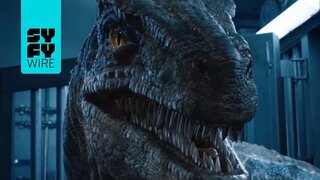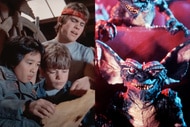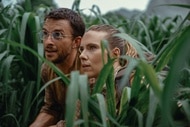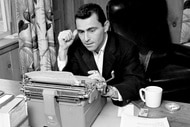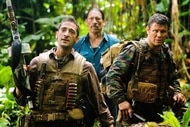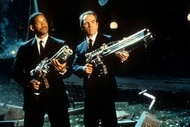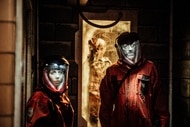How The Exorcist and Angry Geese Shaped the Venom-Spitting Dilophosaurus in Jurassic Park
Spielberg didn't want a rehash of Pazuzu's pea soup.
For six movies across the Jurassic Park and Jurassic World trilogies, the T. rex, Velociraptor, and Brachiosaurus have always received top billing amongst the franchise's prehistoric menagerie. This isn't a bad thing by any stretch of the imagination — they're just three of the most iconic dinosaurs from the original film (now streaming on Peacock alongside The Lost World and Jurassic Park III).
But there's one species that deserves way more screen time than it got, and that's Dilophosaurus, the frilled, venom-spitting terror that stopped greedy computer whiz Dennis Nedry (Wayne Knight) from smuggling InGen's priceless embryos off of Isla Nublar in a Barbasol canister. While not half as gruesome as it is in the novel by Michael Crichton, Nedry's onscreen demise is still a critically dark moment in the Steven Spielberg-helmed film adaptation, serving as a cautionary counterpoint to the awe-inspiring majesty of the herbivores. Being blinded before you're eaten alive is terrifying, and Jurassic Park drives that home in a visceral spray of black, sticky goo.
How The Exorcist changed the look of Dilophosaurus venom in Jurassic Park
In Crichton's book, the Dilophosaurus' blinding venom is described as "a dripping glob of foam," which is certainly effective in a literary context, but not so much in a cinematic one. According to Jurassic Park: The Ultimate Visual History, Spielberg asked for the lethal substance "to be a yellow-green mix." When this was brought to the set by Stan Winston Studio's Shane Mahan, however, Spielberg "changed his mind," feeling it looked too similar to the pea soup-based projectile Regan MacNeil vomits at Father Karras in The Exorcist.
As a result, Mahan quickly pivoted to UltraSlime, "a brand of ready-made goo used regularly in films and stage shows" mixed with black food coloring that the filmmakers shot out of air cannons at Knight during the scene. "The shooting of it was miserable," the actor recalls in the book, referring to the fabricated downpour of monsoon rainfall on the Universal soundstage. "I'm sliding down things, I've got mud all over me, I'm soaking wet, I'm five billion pounds, I can barely walk. Yeah, I loved it!"
The job of giving voice to the Dilophosaurus (or the "Spitter" as it was dubbed by members of the crew) fell to re-recording mixer and sound designer Gary Rydstrom, who would ultimately win an Academy Award for his work on the movie. Wanting to obscure the creature's man-eating proclivities until the last second, Rydstrom began with a "cute little bubbly, hooty sound" taken from swans. That certainly fell in line with the book, which compares the animal's cry to that of a hooting owl. When the Spitter extends its frill and goes in for the attack, Rydstrom mixed the jangling sound of a threatened rattlesnake's with that of angry geese. "Geese turn out to be some of the nastiest things on the planet," he explains. "When they get mad at you, they give you a raspy cough."
The original Jurassic Park trilogy is now streaming on Peacock alongside Jurassic World and Jurassic World: Fallen Kingdom.
